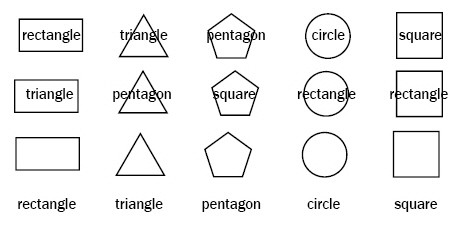Abstract
This is an interesting experiment that explores certain aspects of how your brain pays attention. In this project, you'll have to recruit a bunch of volunteers to take a simple test: naming a list of printed shapes. What makes the test tricky is that words will be printed on top of the shapes. The word/shape combination creates the potential for the brain to get conflicting information. Which information is more likely to grab your attention: the shape you are supposed to name or the word just waiting to be read?Summary
Andrew Olson, Ph.D., Science Buddies
Sources
- Chudler, E. et al., 2006. Neuroscience for Kids: Stroop Effect, Neuroscience for Kids, University of Washington, Seattle. Retrieved May 1, 2007.
- APA, 2007. Interference: The Stroop Effect, American Psychological Association. Retrieved May 1, 2007.
- Stroop, J.R., 1935. "Studies of Interference in Serial Verbal Reactions," originally published in Journal of Experimental Psychology 18: 643-662, available online from Classics in the History of Psychology, York University, Toronto, Ontario. Retrieved May 1, 2007.

Objective
The goal of this project is to determine if printed shape words can interfere with the task of naming shapes.
Introduction
The Stroop effect describes an experiment about the time it takes to name the color of printed words. When you try to name the color in which color words are printed, it takes longer when the color word differs from the ink color than when the color word is the same as the ink color.
To give you an idea of how the Stroop effect works, here is a task for you to try:
- Following this list of instructions are two gray boxes that each contain a list of words.
- The words appear in color on your screen.
- The task is to name the color of the letters of each word (not to read the words).
- Try to the name each color as quickly as possible.
red green blue yellow black white yellow blue black green white red
white black yellow green blue red black yellow white blue green red
Naming the colors was much harder for the second box, right? You may even have felt like you were fighting back an urge to read the color word out loud, rather than naming the color of the letters. This phenomenon was described in 1935 in a now-famous paper by John Ridley Stroop, and is known in experimental psychology as the Stroop effect. One explanation for the Stroop effect is called interference. From the earliest years of school, reading is a task that people practice every day. We become so good at it that we read words automatically. When we are asked to name the color of the word instead of reading the word, somehow the automatic reading of the word interferes with naming the color of the word.
This experiment explores whether interference can occur between when you try to name shapes that are presented with shape words. For example, if you print a square with the word 'circle' in it, does that slow you down when you are trying to name the shape? Figure 1 below has examples to show what we mean, and the Experimental Procedure section has a pdf file that you can download and print (requires Adobe Acrobat).

A diagram helps test respones to stimuli using shapes and names of shapes that are mismatched. Three rows of shapes each contain a rectangle, triangle, pentagon, circle and square. The top row of shapes are labeled correctly. The second row of shapes are labeled incorrectly and the third row of shapes are unlabeled.
Figure 1. Examples of the four different shape/word test stimuli. The first line has shapes printed with matching shape words. The second line has shapes printed with non-matching shape words. The third line has shapes alone. The fourth line has shape words alone.
Will the mis-matched shape words interfere with naming the shapes? Will the matched shape words speed up naming the shapes?
Terms and Concepts
To do this project, you should do research that enables you to understand the following terms and concepts:
- Attention
- Perception
- Interference
- Anterior cingulate gyrus
- Cognitive psychology
Questions
- How does the concept of interference help to explain the Stroop effect?
Bibliography
- Try these webpages for background information on the Stroop effect:
- Chudler, E. et al., 2006. Neuroscience for Kids: Stroop Effect, Neuroscience for Kids, University of Washington, Seattle. Retrieved May 1, 2007.
- APA, 2007. Interference: The Stroop Effect, American Psychological Association. Retrieved May 1, 2007.
- This article from Science News shows how Stroop's experimental work from 1935 has had a lasting influence on experimental psychology. You may be able to find it at your local library:
Bower, B., 1992. "Brother Stroop's Enduring Effect: A Mental Task Devised Nearly 60 Years Ago Still Intrigues Psychologists," Science News 141: 312-314. - This is the original paper, from which the Stroop effect gets its name:
Stroop, J.R., 1935. "Studies of Interference in Serial Verbal Reactions," originally published in Journal of Experimental Psychology 18: 643-662, available online from Classics in the History of Psychology, York University, Toronto, Ontario. Retrieved May 1, 2007.
Materials and Equipment
To do this experiment you will need the following materials and equipment:
- Computer with a color printer
- Four sheets of cardstock (available at an office-supply store or stationer)
- Four envelopes
- Stopwatch
- Volunteers to take a simple color-naming test
- To see how many volunteers you need, check out the Science Buddies resource Sample Size: How Many Survey Participants Do I Need?.
- For ISEF-affiliated science fairs, studies involving human subjects require prior approval. For more information, see Projects Involving Human Subjects.
Experimental Procedure
Note: for ISEF-affiliated science fairs, studies involving human subjects require prior approval. For more information, see Projects Involving Human Subjects.
- Do your background research so that you are knowledgeable about the terms, concepts, and questions, above.
- Click the pdf file with four pages of test stimuli (requires Adobe Acrobat) that you can use for this project.
- Page one in the file has shapes (circle, square, triangle, rectangle, pentagon) printed with matching shape words.
- Page two in the file has shapes printed with non-matching shape words. (Each shape appears with the each of the four non-matching words five times.)
- Page three in the file has shapes alone.
- Page four in the file has shape words alone.
- Print the file on four separate pages of card stock (for sturdiness), then cut them into horizontal strips.
- Lightly label the backs of the strips, and keep the four sets in separate envelopes.
- Your volunteers will call out the shapes as they scan through the strips.
- For each volunteer, instruct them on what they are supposed to do in the test:
- You will be given cards containing sequences of shapes and/or shape words.
- The shapes used are circle, square, triangle, rectangle, and pentagon.
- The task is to call out the name of each shape as quickly as possible, without making a mistake.
- Time how long it takes for the volunteer to name the shapes of each test set (four different sets).
- Mix up the order of presentation of the sets for different volunteers.
- Calculate the average time to name the shapes for each set (matching shape words, non-matching shape words, shapes alone, shape words alone).
- Calculate the time differences for each volunteer between the time to name the shapes with non-matching shape words and the shapes with matching shape words.
- Calculate the time differences for each volunteer between the time to name the shapes alone and the shapes with matching words.
- Calculate the time differences for each volunteer between the time to name the shapes with matching shape words and the shape words alone.
- Make bar graphs to illustrate your results.
Ask an Expert
Global Connections
The United Nations Sustainable Development Goals (UNSDGs) are a blueprint to achieve a better and more sustainable future for all.
Variations
- Does interference still occur if the test words are turned upside down or rotated 90℃? Design an experiment to find out.
- Another way to investigate the finding would be to look for the effect with youngsters who know their shapes but don't yet know how to read. Would you expect to find the Stroop effect in this age group?
- For an experiment on interference with colors and color words, see the Science Buddies project What Conflicting Mental Tasks Reveal About Thinking: The Stroop Effect.
Careers
If you like this project, you might enjoy exploring these related careers:









